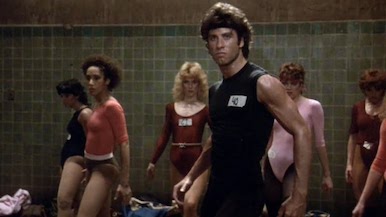The Number One Movie in America: Staying Alive
By Sean Collier
October 4, 2020
BoxOfficeProphets.com

Sort of. Kinda.
A bit.
Tony Manero is there, anyway, once again played by John Travolta in the best shape of his life (almost uncannily so), as the former dance-floor king attempts to become a star on Broadway. Though he retains the name, the moves and a very laissez-faire understanding of how to behave in a romantic relationship, this isn’t really the same guy from the original film; he’s lost all the edge and anger that propelled Travolta to an Oscar nomination in 1977.
Yes, this is also a dancing movie — though the setting of “Staying Alive,” an avant-garde mid-’80s dance company, is worlds away from the light-up floor of the late ’70s. Here, Manero and a couple of new flames played by Cynthia Rhodes and Finola Hughes — neither of the love interests from “Saturday Night Fever” turn up — are working on an over-the-top modern dance production called “Satan’s Alley,” without a disco move in sight.
And yes, there are songs by the Bee Gees, just not the ones you remember. The title track — or almost the title track, as the movie added the letter G back onto the end of “Stayin’ Alive” — plays over the end credits, but the Gibb family originals here are tunes such as “The Woman in You” and “Someone Belonging to Someone.” In fact, the biggest hit from “Staying Alive” was neither by the Bee Gees nor a disco tune; it was Frank Stallone’s “Far From Over,” which charted at #10 and landed a Golden Globe nomination.
So “Staying Alive” is, I suppose, just barely related to “Saturday Night Fever.”
The presence of Frank Stallone is no accident. “Staying Alive” is directed by his brother, a guy you may have heard of named Sylvester. This is one of the three non-Rocky, non-Rambo movies Stallone has helmed, and it has a certain number of his signature themes to show for it; in this telling, Manero is a plucky underdog looking for his shot at the big time.
Does it work? Not especially. While there are more than enough memorable scenes in “Staying Alive,” particularly the wild performance of “Satan’s Alley,” the production as a whole is too disjointed, repetitive and flat to really hang together. Rhodes is good, but Travolta seems too concerned with looking cool to worry about actually acting. The conflict is vague, the stakes are non-existent and the attempts to tie things back to “Saturday Night Fever,” like a brief dinnertime talk with Mrs. Manero (the returning Julie Bovasso), are clunky.
None of this prevented “Staying Alive” from becoming a hit, as the presence of then-megastar Travolta and tenuous ties to a box-office giant brought audiences to the theater. The film grossed a total of $64.8 million, landing in eighth on the year-end chart and outgrossing such blockbusters as “Superman III,” “National Lampoon’s Vacation” and “Risky Business.”
Perhaps that dichotomy, between an odd and fundamentally bad film and stellar box office, explains the toxic reputation of “Staying Alive.” The film is regarded as a notorious stinker, maintaining a rare 0% score on Rotten Tomatoes; in a 2006 retrospective, Entertainment Weekly ranked it atop a list of the worst sequels ever made.
While it’s certainly bad — I regret to inform Mr. Stallone that I will not be breaking the 0% Tomatometer with this review — it’s not as bad as all that. A few scenes work; a few performances hold together. Frank Stallone’s “Far From Over” is a jam.
Let’s not forget: “Saturday Night Fever,” a soundtrack in desperate need of a plot, isn’t that good, either. Perhaps “Staying Alive” was reviled not for sullying the reputation of the original but for laying bare that its predecessor was nothing special in the first place.
“Staying Alive” is the subject of the latest episode of The Number One Movie in America, a look back at past box-office champions. Each episode’s film is drawn at random from a list of every number-one movie since 1977. Please listen and subscribe!
Next time: It would be inaccurate to say that Michael Myers is back, since he never actually left.